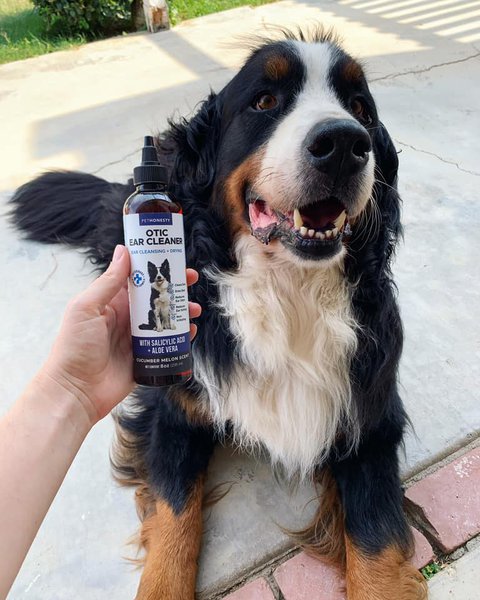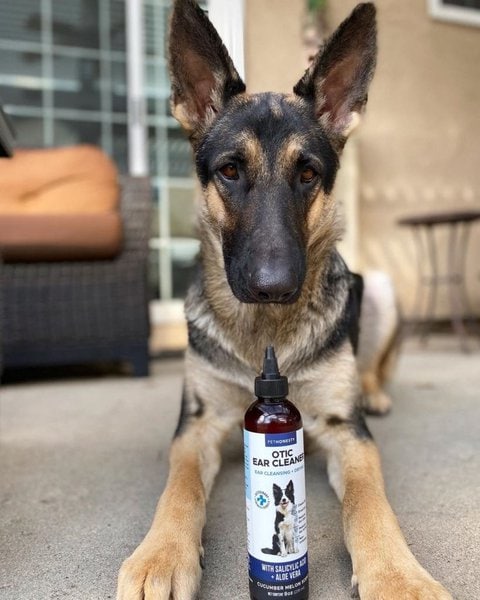The best dog ear cleaner is Zymox Otic Enzymatic Solution.
Do you clean your dog’s ears? If not, you need to start.
You may think that your dogs’ ears are clean since they can hear just fine, but that is not always the case. Just like our human ears, a dog’s ears need to be cleaned regularly in order to avoid undue amounts of earwax, bacteria, and other nastiness from gathering and causing irritation, infections, or worse.
So, what is a dog ear cleaner? These are specifically formulated solutions to remove wax and other debris from your dog’s ears safely and effectively. They’re also designed to leave ears smelling fresh, and with a healthy coat of cerumen or “dog wax” that helps keep ears from drying out.
Let’s explore the 8 best dog ear cleaners that you can currently get for your pooch right now.
#1 Zymox Otic Enzymatic Solution
The Zymox Otic Enzymatic Solution is absolutely the best dog ear cleaner on the market simply because it works every single time. No matter the type of ear infection in the ear canal that your dog is dealing with – ranging from ear mites to yeast infection to something like staphylococcus aureus – it just wouldn’t fail to amaze you with the results it would get.
The effectiveness of this ear cleaner is clearly reflected in the fact that it has gotten almost universally positive reviews – which is not often seen on online selling platforms like Amazon – least of a product in the pets category.
What’s even better is that it manages to be so effective without containing an antibiotic, so it would also work just as effectively against infecting agents that may be resistant to antibiotics.
It boasts a powerful, patented LP3 Enzyme system that ensures fast, effective and safe treatment, regardless of how resistant the microbes affecting your dog’s ears are.
You may start seeing the results literally in a few hours, and the infection would likely be a thing of the past within a week or less.
This dog ear cleaner has worked for infections where most other ear cleaners failed. It has been approved by tens of thousands of dog owners. It can be used with hydrocortisone for treating an ear infection for faster results, and without it when you’re just using it for routine ear cleaning.
Pros
- Zymox Otic Enzymatic Solution is an effective treatment option for canine acute and chronic otitis externa caused by bacterial, fungal, and yeast infections.
- The Zymox ear cleaner features a 3-point enzyme system that can effectively destroy microorganisms like Staphylococcus, which are resistant to antibiotics.
- Customers can use this enzymatic solution either as an ear cleaner or to treat existing ear infections.
- The no-sting formula of this enzymatic solution is gentle and safe enough to use on a dog’s ears.
- The hydrocortisone contained in this enzymatic solution provides a dog with relief from itching and inflammation.
Cons
- The Zymox Otic Enzymatic Solution is quite expensive, compared to other ear cleaners available on the market.
- Information gathered from multiple customer reviews suggests that this enzymatic solution isn’t effective for treating ear infections in all dog breeds.
This is essentially our top pick because its LP3 Enzyme System is very effective against myriad of fungal, bacterial, and parasitic ear issues; plus, there is no need to pre-clean the dog’s ears before application, reducing the hassle.
#2 BEXLEY LABS Curaseb Dog Ear Cleaner
While the above ear cleaner is the best you can buy, it’s a bit expensive. And given that you need to use a dog ear cleaner very liberally for best results, the cost can add up.
So some dog owners may want to go for a more budget-friendly product, which is exactly what BEXLEY LABS Curaseb Dog Ear Cleaner is.
It works very effectively as well and treats a variety of dog ear infections. However, it can take longer than the above ear cleaner for it to make a significant difference, but that’s a bit of a trade-off for the lower price.
Blended with a unique formula that’s a combination of antifungal, anti-yeast, and antibacterial ingredients, this ear cleaner also helps to defend the ear canal from infection.
When comparing with the top pick, the BEXLEY Labs is around 85% cheaper. This makes it a no-brainer budget-conscious option for dog parents.
It offers a great bang for your buck, especially for routine ear cleaning, as it’s impressively effective but priced much lower than its peers. It contains 0.1% ketoconazole, which is known to be effective against yeast, bacteria, fungus, and ear mites.
Pros
- This broad-spectrum antiseptic ear flush is ideal for treating dog ear infections, inflammation, and itchiness, due to the use of ketoconazole as the active ingredient.
- This no-sting dog ear cleaner is safe and gentle to use on puppies as well as adult dogs.
- This medicated ear cleaner from BEXLEY LABS is effective for deodorizing smelly ears from wax, dirt, and sticky discharges.
- To ensure compliance with safety regulations, the BEXLEY LABS dog ear cleaner is manufactured in federally regulated facilities located in the United States.
- This ear cleaner comes with a dropper for convenient application to an infected dog’s ears.
Cons
- This dog ear cleaner comes with a strong scent that some customers may find to be too strong or overwhelming.
- Some users have commented that this ear cleaner left their dogs’ ears red and inflamed after use.
#3 VetWELL Dog Ear Cleaner
This is one of the cheapest canine ear cleaners you will find for cleaning your dog’s ears, but its low price tag doesn’t take anything away from its effectiveness.
It works great for routine ear cleaning and helps get rid of all the dirt and dust in the ear canal in no time.
The formulation is effective against relieving the symptoms of ear infections such as painful itching, scratching, and bad ear odor. Although this ear cleaner does not guarantee to work against ear mites, some dog parents have mentioned that it’s effective against them too.
For the more concerned dog parents, do take note that this ear cleaner does contain alcohol, which only makes up less than 5% of the solution. Alcohol is added to create a dry environment for ear maintenance. Regardless, some dog owners would want to take this into consideration, although it shouldn’t turn out to be a problem unless your dog has sensitive ears or skin.
With a low price tag and effectiveness against some common ear infections, the VetWELL ear cleaner is a trusted option among dog parents. It has more than 5,600 reviews, with an average rating of 4.6 out of 5.0.
Pros
- The VetWELL ear cleaner uses aloe vera leaf to provide a soothing effect on inflamed and infected dog ears.
- This ear cleaner is formulated to control ear discharge and dirt, eliminate foul odors and prevent the buildup of wax in a dog’s ears.
- In addition to its cleaning properties, regular usage of the VetWELL cleaner helps reduce the chances of a dog developing ear infections.
- The VetWELL cleaner is scented – comes in options of cucumber melon and sweet pea vanilla – to help keep a dog’s ears odor-free.
- VetWELL cleaners are manufactured in federally regulated facilities located in the United States, to ensure the production of cleaners that are safe to use on dogs.
Cons
- This ear cleaner doesn’t work effectively on all dogs.
- The VetWELL ear cleaner contains a percentage of alcohol that can irritate and worsen existing dog ear infections.
#4 Pet MD Otic Clean Dog Ear Cleaner
Another budget-friendly ear cleaner that’s ideal for routine ear cleaning. If your dog has a lot of wax, dirt, and debris buildup in the ear canal and their ears, you will find the little guy shaking their head after you apply this directly into their ears.
Let your dog do that as the dirt, debris and fluid would start coming off, and it would fall around on the ground when they shake their head.
Now, truth be told, it’s very effective at keeping ear infections at bay, but not as effective for treating them if your dog has already fallen prey to them.
It also contains alcohol which can make your dog’s ears burn if they are sensitive to it.
All said and done, it would serve you well for routine ear cleaning and preventing ear infections without burning a hole in your pocket.
Despite being priced so cheap, it works surprisingly effectively for the most stubborn of wax and dirt buildup. It also starts showing results fairly quickly and works well for minor ear infections too.
Pros
- This canine ear cleaner contains Aloe Vera to soothe the inflammation, itching, and irritation of dog ears.
- The PET MD cleaner has a sweet pea scent that provides a pleasant fragrance and ensures that a pooch’s ears are odor-free.
- To ensure that this product is safe to use for cleaning dog ears, Pet MD manufactures its dog ear cleaners in US-based facilities.
- Constant use of the Otic ear cleaner eliminates the head shaking and scratching associated with wax, fluid, and dirt build-up in a dog’s ears.
- PET MD’s ear cleaner is good for preventing the buildup of yeast and other bacteria in a dog’s ear canal.
Cons
- The Pet MD cleaner contains alcohol that can cause irritation on dogs with sensitive skin or those suffering from ear infections.
- This ear cleaner tends to pour out quickly from the bottle during the application, thereby making a mess in the process.
#5 Gimborn Pet Specialties R-7 Ear Powder
Maintenance of ear health is important in ensuring the overall well-being of our pets, and with the Gimborn Pet Specialties R-7 ear powder, dog and cat parents can effectively achieve this.
This ear powder reduces wax build-up within a pooch or cat’s ears, thereby helping to keep the ears dry and preventing the development of ear infections which can be detrimental to our furry friends’ health.
In addition to keeping a dog’s ears dry, the Gimborn ear powder is effective in removing debris located within the pet’s ear canals, and the application of this product is done by simply puffing the powder into clean ears.
The Gimborn R-7 ear powder provides an effective solution for pet parents looking to be proactive and prevent the development of ear infections in their furry friends. The suitability of this powder for use on both cats and dogs makes it perfect for multi-pet households, and it is also simple to apply on pets.
Pros
- This Gimborn Specialties product comes in powder form and can be conveniently applied by squirting the bottle’s top and directly pouring it into the dog’s ears.
- The R-7 ear powder is effective for use in removing excess hair that can trap moisture, bacteria, and odors from a dog’s ear canal.
- Customers only need to apply small quantities of the R7 powder to clean their dogs’ ears, and with proper preservation and usage, this powder can last for a considerable period.
- Gimborn Pet Specialties powder contains the Rosin grip that helps to improve grip and reduce slipping for customers plucking hair from their dogs’ ears.
Cons
- Multiple customers have reportedly received bottles of this Gimborn product that are half filled with ear powder or, in some cases, completely empty.
- Some customers were also left unimpressed by the fact that they had to use tweezers to remove hair from their dogs’ ears after applying this powder.
#6 NaturPet Dog Ear Drops
If you’re one of those dog owners that like to go all-natural for your dog, then the NaturPet Dog Ear Drops is the ear cleaner for you.
Blended using 100% natural ingredients, this dog ear drop only contains herbs and roots that come with antibacterial, antifungal and anti-viral properties. It also doesn’t contain cortisone like some other ear cleaning solutions, which is basically a steroid that’s not recommended to be used liberally on your dog.
It works particularly well for pain relieving and ear inflammation or scratching but isn’t the most effective cleaning solution for the more serious infections like a fully grown yeast infection.
It’s also effective for gunk and dirt, while also helps prevent the swimmer’s ear in dogs by keeping the ear canal clean and dry.
The fact that it’s completely natural is its biggest selling point. Also, it is made in Canada in a GMP-certified facility.
Pros
- NaturPet ear drops come in a convenient dropper for straightforward application into a pooch’s ears.
- This NaturPet ear treatment works effectively for both inner and outer dog ear infections.
- The use of natural oils and herbs to formulate NaturPet dog ear drops ensures that this is a product that is safe to use on dogs.
- The natural oils included in this product are good for soothing inflamed and irritated ears, as well as relieving the pain associated with ear infections.
- NaturPet dog ear drops can help prevent dogs from developing ear infections by inhibiting the growth of bacteria, virus and yeast.
Cons
- This product isn’t effective for treating ear infections in all dog breeds.
- NaturPet ear drops caused some pooches to develop inflammation and irritation after application.
#7 Vet’s Dog Ear Cleaner Kit
Here’s another ear cleaner, the Vet’s Dog Ear Cleaner Kit, that only contains natural ingredients. It’s actually also a kit and not just a cleaning solution, so you get a bottle for “wash” and another labeled as “ear relief dry.”
The first liquid helps to offer fast, effective relief from painful, irritated ears and itching, while the second one helps keep the ears and ear canal clean for a longer period of time.
As it’s completely natural, it would be a better choice for puppies and dogs with large or sensitive ears.
The “dry” solution is really useful, as it helps prevent the discomfort to a great extent that may be caused to your dog when using the cleaning solution.
It does have a smell though so make sure your dog isn’t allergic to it or dislike it.
The “coordinated” treatment is a unique feature and it does turn out to be more effective than just using a cleaning liquid.
Pros
- This dog ear cleaner kit is formulated with a blend of alcohol-free ingredients that are gentle and have a non-stinging effect on dog ears.
- The 2-step process of this cleaner kit effectively provides quick relief for dogs suffering pain from ear infections while simultaneously curbing ear odors.
- The Vet’s Dog ear cleaner kit contains aloe vera, which has a soothing effect on inflamed and irritated dog ears.
- This ear cleaner kit is safe and gentle to use on dogs with sensitive skin.
- Vet’s Dog ear cleaner kit is formulated for and safe to use on all dog breed sizes.
Cons
- Several customers commented that the products contained in this cleaner kit have an unpleasant vinegar scent.
- Multiple dogs reportedly developed blisters and ear infections after using this ear cleaning kit.
#8 Vetoquinol Ear Cleaning Solution
This dog ear cleaner is one of the few products in this price range with almost universally positive ratings and reviews, which speaks volumes about its effectiveness.
A particular customer has been using it for about 12 years, and it hasn’t let them down a single time. It works against many different types of allergies, while also being a great choice for the usual cleaning.
The Vetoquinol Ear Cleaning Solution also helps keep the dog’s ears and ear canal clean and dry, so it will also come in handy to protect your dog’s ears before getting wet.
While it’s fairly gentle for most dogs, it does contain alcohol so it may not be a good fit for dogs with sensitive ears.
It’s one of the most effective dog ear cleaners in this price range. It does have alcohol but surprisingly, it manages to be mild enough to not make your dog object to it.
Pros
- Vetoquinol’s ear cleaning solution is available in different sized bottles – 4 oz, 8 oz, 16 oz, and 1 gallon – to suit customers’ needs.
- This ear cleaning solution is approved for safe use in dogs by the National Animal Supplement Council (NASC).
- The Vetoquinol ear cleaning solution contains denatured alcohol and lactic acid for drying and acidifying a dog’s external ear canal.
- The soothing aloe vera gel used in manufacturing this cleaning solution helps to soften and soothe a dog’s external ear canal.
- This ear cleansing solution can be applied to effectively clean and dry a dog’s ears after swimming.
Cons
- The alcohol contained in this ear cleaning solution may be too strong to use on some dogs with sensitive skin.
- This ear cleaning solution comes with a strong scent that can be overwhelming for both humans and dogs.
Dog Ear Cleaners Buyer’s Guide
Ear infections in dogs can be a result of a variety of factors but are mainly related to either bacteria, fungi, or mites.
What Causes Ear Infections?
Bacterial infections are the most common though, with the most common ones affecting dogs being Pseudomonas Aeruginosa, Proteus Mirabilis, and Escherichia Coli. Based on feedback from dog owners, our top pick dog ear cleaner is effective against all of them and many more.
Then comes the fungi, which are primarily the culprit as far as the yeast and other similar infections are concerned.
One of the most troubling fungi is Malassezia Pachydermatis, which can multiply to worrying levels if not dealt with in time. Infections caused by Malassezia Pachydermatis are usually marked by serious irritation and inflammation of the ears.
Ear mites, on the other hand, are basically eight-legged tiny insects that are notorious for entering dogs’ ears and causing great discomfort to them. When infected with ear mites, a dog would usually be found pawning at ears every now and then, and in many cases, end up pawning it to the extent of bleeding.
Ear mites are much more common in puppies than large dogs due to the former’s immune system not being as strong as the latter. However, large dogs, too, can fall prey to ear mites, especially if they tend to roam around outside.
It’s important to note that these infections, if not taken care of in time, can lead to a bruised or broken skin, or even ruptured ear canals. This would not only make it more painful for the dog but also harder to treat the infections.
Many dog ear cleaners cannot be applied directly on bruised or broken skin (or when treating ruptured ear canals for that matter), so you may have to follow a more complicated treatment option.
Finally, it’s also not uncommon for dogs to end up catching a dog infection due to a foreign element making its way to your dog’s ear. In such cases, it would be even more important to make sure that the cleaning solution reaches the ear canal of your dogs for fast treatment.
Related: Best Dog Grooming Tables
Common Symptoms Of Ear Infections
Here’s a quick list of symptoms that may mean that your dog is dealing with some kind of ear infection.
- Shaking head much more often than they usually do.
- Constant pawning at the ears, sometimes to the extent that it makes their ear red and swollen, or makes them bleed.
- Flapping of ears.
- A bad odor coming off from their ears.
- A discharge from the dog’s ears.
- Whining when pawning the ears, or doing it with frustration.
- Irritated or inflamed ears.
- Unusual itchiness at the ear area, making them do things like scratching their ears or rubbing them against the ground.
- In many cases of ear mite infection, the mites are clearly visible.
- Others that may suggest something is wrong with their ears.

Should You See A Vet?
When doing research for the canine ear cleaners which we reviewed in this post, we found many dog owners saying that they first went to their vet before buying a particular dog ear cleaner. Some of them mentioned that they used to always visit a vet before until it got too expensive for them to do so and they decided to try out a dog ear cleaner instead.
Furthermore, some even said that their vet’s treatment didn’t turn out to be effective enough for them, but using one of the dog ear cleaners above did.
So, to answer your question, no, it’s usually not necessary to visit a vet for treating an ear infection. In fact, our best dog cleaner reviewed at the top is effective enough for treating most types of ear infections.
That said, if you find that your dog is showing no signs of improvement even after 5 to 7 days of using one or two of the dog ear cleaners above (not all products work for all dogs or all cases), then you must visit a vet immediately.
In very rare cases, an ear infection may not just be an ear infection, but also something much more serious such as a tumor.
Similarly, if your dog also has a bruised skin with an ear infection, then you may want to seek the help of a vet instead of trying to treat it yourself. It’s not easy to treat ear infections with bruised skin due to the reasons discussed above.
Finally, if your dog has never had an ear infection before, then it makes sense to visit your vet just to confirm that it’s actually an ear infection that your dog is suffering from. For recurring infections or routine ear cleaning, however, treating it using one of the ear cleaners reviewed above may very well turn out to be both effective and much more economical.
Related: Emergency Vets Near You
Things To Keep In Mind When Using a Dog Ear Cleaner
Apart from the fact that most dog cleaners shouldn’t be used for dogs with bruised skin, there are other things to keep in mind as well. Let’s take a quick look at them.
- Many dog ear cleaners like the ZYMOX ear cleaner require that you do not clean your dog’s ears before applying the ear cleaner for best results.
- Similarly, some of them require you to flush your dog’s ears after use or letting your dog shake their head.
- You also need to remove the excess, especially what doesn’t manage to get to your dog’s ear canal.
- The frequency of use must be higher than when only using the ear cleaner for routine ear cleaning.
- Almost all ear cleaners require to be used in generous quantities.
- You need to shake them well before applying them to your dog’s ears.
- Never let the cleaning solution go into your dog’s eyes; if it does, you may have to visit your vet immediately.
- If the irritation increases after using the ear cleaner, you need to stop using it and visit your vet.
- The ear cleaners containing alcohol are typically not recommended for dogs with a sensitive skin.

Black Earwax In Dogs: Should You Be Worried?
It’s quite common for dogs to suffer from different ear problems, most especially dog breeds that have droopy and long ears. Although a small amount of discharge and earwax is normal, if it comes in a large amount, then it can be a problem. Also, some dogs might end up having black wax in their ears, which can be alarming to pet parents.
Here’s everything you need to know about black earwax on dogs.
What Is The Cause Of Black Earwax In Dogs?
There are many reasons why your dog ends up with black earwax on its ears. This condition might be due to the accumulation of dirt in your dog’s ears. Other causes could be ear mite infestation and ear infection.
In some instances, excessive earwax in your dog’s ears could result in an ear infection. On the other hand, an ear infection may also cause excessive buildup of earwax in your dog’s ears.
Basically, earwax produced in a huge amount, and the accumulation of such wax in your dog’s ears could cause ear infection, which will eventually turn black. There are also instances when black earwax and ear infections on dogs can be due to some other factors, such as an infestation of ear mites.
What Are The Symptoms?
If you see black earwax in your dog’s ears, consider this as a sign of ear infection. Your canine companion might also show other symptoms, such as constant shaking of the head and scratching of the ear area. In some instances, you’ll notice swelling, redness, and pus inside your dog’s ears. The ears of your pet might also produce a bad odor. If it’s accompanied by other symptoms, then you better call a vet immediately.
Steps To Treat Black Earwax
Treating the back earwax in dogs will mainly depend upon the underlying causes. Therefore, the first step is to take your pooch to a vet. The vet will diagnose your pooch and find out the reason behind the buildup of black earwax and determine the proper treatment.
Pet owners should also consider getting a dog ear cleaner to help clean their dog’s ears. That way, the accumulation of black earwax will be substantially minimized, and ear infection will be avoided as well. Using a dog ear cleaner is very easy and straightforward.
In fact, it’s a convenient way to clean your pet’s ears. Simply soak a cotton ball with the ear cleaner and apply it to your dog’s ears. Gently massage the ears afterward and wipe gently to remove any remaining wax.

Dog Ear Wax: Does Your Dog Have Excessive Ear Discharge?
Similar to humans, dog ears tend to produce ear wax, and this is perfectly natural. But, if you notice that the amount of wax in your dog’s ears is a bit too much, there might be a problem there. It could be a sign of an ear infection or a parasite. In scientific circles, ear wax is referred to as cerumen, and it typically emanates from the ear canal for protection purposes.
However, if there’s too much wax coming out of your dog’s ears, then this could attract all kinds of severe health issues, including painful ears, ear mite infestations, fungal infections, and bacterial infections. The pain can be unbearable when the wax is buried deep in the ear canal.
That’s why it’s essential to make sure your dog’s ears don’t accumulate too much wax as it could lead to some of the health issues mentioned above.
What Causes Excess Earwax in Dogs?
Excess ear wax in dogs can be caused by several different factors. However, allergies are the most common reason, which is probably why allergy-prone dogs tend to scratch their ears a lot.
If left untreated, excess earwax can cause your dog to develop inflammation.
Ear Infections
Ear infections are typically the main cause of ear discharge and excess wax in dogs. That’s because your dog’s system produces the earwax to protect the affected area from further inflammation. A dog that has a habit of constantly scratching its ears will be more susceptible to inflammation and ear discharge as well.
However, you can train your dog to stop scratching its ears excessively by rewarding it with treats whenever your pooch sits still or using the “cone of shame” method.
It may take a long while to wean your dog away from scratching its ears using these methods, but they do offer a permanent solution.
Ear Mites
It’s not uncommon for dogs to get ear mites, and this is a highly contagious condition that easily spreads between animals when they’re in close proximity. This means that if one of your pets gets ear mites, the rest will probably follow.
Ear mites can cause excessive ear wax that has a reddish-brown appearance as well as inflammation. A great way of keeping ear mites at bay is to have regular cleaning of your dog’s ears or flush them out at least once a month.
Speak with your local veterinarian to ask for a recommendation on the best dog ear cleaner to use to get rid of debris, wax, and ear mites.
Allergies
If you suspect your dog has allergies, always consult with your vet first. That way, you can figure out what type of allergen he has so you can reduce or eliminate exposure to the aggravating material or substance.
Your vet will be able to prescribe suitable medication for the specific allergy that your dog suffers from. Allergy treatment is usually the only available treatment for excessive ear discharge in some dogs.
But, you need to be disciplined as a pet owner so you can make sure that you administer the medicine in the right doses and at the right time.
Why Use A Dog Ear Cleaner?
As a pet owner, you don’t want to see your dog go through any type of pain or discomfort. Unfortunately, that’s what happens when pets develop excessive ear discharge and infections. The best way to keep this from happening to flush or clean your dog’s ears regularly using a vet-approved ear cleaner.
This is a great way to prevent the build-up of wax and inflammation while keeping ear mites at bay.

How To Clean Your Dog’s Ears: A Complete Guide
One of the grooming skills that pet owners should learn is how to clean their dog’s ears. This can be somewhat tricky, especially for new pet owners who may not even know how often they should clean their dog’s ears.
So to help you with this, here’s everything you need to know on how to clean your pet’s ears and how often you should be doing it.
How Often Do You Have To Clean Your Dog’s Ears?
For dogs that are prone to ear infections, regular cleaning of your pet’s ears is crucial. But how often you should consider cleaning your dog’s ears? The answer will mainly depend on your pooch. Nevertheless, you should clean your pet’s ears often enough to prevent infections.
For some dogs, cleaning their ears once a month should be enough. But for other dogs that are prone to ear infections, cleaning their ears should be done every other week. Or if possible, it must be done once a week.
If your dog has already suffered from an ear infection in the past, the vet will most likely recommend that you clean its ears every day or every other day. Of course, the infection must also be treated with medications aside from cleaning the ears. But even if your dog has not suffered from an ear infection, cleaning their ears should be necessary, especially if they smell bad or look dirty.
Remember that your dog’s ears shouldn’t smell bad. If they produce a foul odor or yeasty smell, then consider that as a sign that your dog’s ears might be infected, and it’s about time that you take it to the vet. Other signs of ear infection are red and inflamed ears, ear discharge, and constant scratching and shaking of the ears.
Also, if your pet shrieks or cries whenever you touch its ears, then that means there’s a problem. When your dog’s ears are infected, this can be extremely painful for your pooch, so make sure to seek immediate medical treatment from your local veterinarian.
Step By Step Guide For Cleaning Your Dog’s Ears At Home
Here’s a step-by-step guide on how to properly clean your dog’s ears.
- First, prepare some cotton balls. You can also use gauze or any vet-approved dog ear cleaner. Make sure you seek approval from your vet before using any product on your pet’s ears to ensure that it’s safe and gentle for your pooch.
- It can be quite messy to clean your dog’s ears, so you need to prepare yourself for this. This is especially the case if the ears of your pet are extremely dirty. Consider cleaning during your dog’s bath so you can easily wash and clean up the mess afterward.
- To clean, squeeze a small amount of ear cleaner into your pet’s ears and leave it to drip towards the ear canal. Gently massage around your pooch’s ear to spread the cleaning solution. This helps to break down the debris and wax. Let your pooch shake its head to remove the gunk.
- Make sure you wipe your dog’s outer ear flap after cleaning. Include the inside ear as well. You can use gauze square or cotton ball for this. Wipe the ears as far down as you possibly can with the use of the gauze or cotton ball. Ear cleaners for dogs have a drying agent so anything that gets stuck on your dog’s ears will eventually dry up on its own.
- You can use either a solution or a dog ear cleaning wipe.
For An Existing Ear Infection, Here’s A Few Additional Steps
- If your dog has an ongoing ear infection and requires medication for treatment, apply the medication only after the ears have been cleaned and wiped. If you’re going to apply medication and the ears are dirty, it will defeat the purpose. Your dog will not be cured of the infection, and the treatment will be a waste.
- When applying an ointment for treatment, try to position the tip of the dog cleaner just well above the ears, so you will see how many drops are getting into the ears of your pooch. Then gently massage the ear below.
Why Use A Dog Ear Cleaner?
You should definitely buy a dog ear cleaner for your pooch if your dog suffers from an ear infection. This way you will prevent wax buildup and dirt which are usually the main causes of ear infections.
By using a dog ear cleaner, you will also be able to kill any bacteria that could be present and your dog won’t suffer from an ear infection anymore.
Inner Ear Infection (Otitis Interna) In Dogs: Everything You Need To Know
There are certain dog breeds that are more prone to getting ear infections (Otitis Interna) than others. For instance, dogs with floppy ears, such as the Cocker Spaniels and Basset Hounds, are at high risk of getting ear infections compared to dogs that have upright ears. Also, if your dog spends a lot of time in the water or swims a lot, then it’s at high risk of getting an ear infection.
Usually, when too much moisture is trapped in the ears, bacteria will eventually develop, leading to infection. This condition is very painful for dogs and requires immediate treatment.
What Is Inner Ear Infection In Dogs?
Ear infection, or medically known as Otitis Interna, refers to the inflammation of the inner ear. Also known as otitis interna, this condition is usually due to the bacteria that eventually infect the animal’s ears. The presence of yeast or fungus can also trigger an infection in your dog’s ears.
If there are ear mites in your dog’s external ear canal, this could eventually cause a problem in your dog’s inner ear and poses a great risk for bacterial growth that could trigger infection. An inner ear infection may also develop if there’s a disease on the ear canal of your pup or if a benign polyp is starting to develop in the middle ear.
Furthermore, an ear infection may also be due to some external irritants getting stuck in your dog’s ears, such as grasses, tiny rocks, dirt, etc.
Dog Inner Ear Infection Symptoms
The signs and symptoms of ear infection will greatly vary, depending on the severity of the infection. There are some dogs that don’t show any signs or symptoms at all. But if you notice that your dog is somewhat hesitant to chew or is feeling pain in the ear area, then consider this as a sign of ear infection.
Also, if your canine companion is constantly shaking and tilting its head while scratching its ears, then that might be due to an infection.
Dogs with an ear infection may develop a head tilt, which means that they will usually lean on one side most of the time. This could make your pet lose its balance completely and will find it difficult to walk. Some dogs will also walk in circles, often heading in the direction of the ear that was infected.
Furthermore, dogs suffering from otitis interna might not be able to hear anything with the affected ear.
How To Treat Otitis Interna In Dogs?
Dog owners should understand that otitis interna is a serious condition. If your canine buddy can’t eat or drink as a result of this condition, hospitalization may be required for your pet to be administered with intravenous fluid therapy.
Dehydration must be avoided and nausea should be controlled. Sometimes, the vet recommends sedating the dog. If your pooch is suffering from extreme pain, anesthesia might be injected. For proper diagnosis, the vet would take samples of bacteria culture from your pooch’s ears.
Are There Any Potential Long-Term Effects?
Remember that severe ear infection has the potential to spread in some other parts of your dog’s body, most especially the brain. This may also affect your dog’s heart rate and breathing. Also, long-term complications could lead to an altered sense of balance and could be a sign of Horner’s syndrome.
In the worst cases, your dog could become permanently deaf.
Therefore, it’s very important to provide proper medical treatment to dogs suffering from Otitis Interna. Depending on the severity of the condition, you can expect a 2 to 4-month period of oral antibiotic treatment.
How Does A Dog Ear Cleaner Help?
Whether your dog is prone to an ear infection or not, you should consider getting a dog ear cleaner for your pooch. This product is easy to administer. Simply soak a cotton ball on the cleaner and massage it gently on your pet’s ear canal.
A dog ear cleaner is very useful in preventing the buildup of wax and dirt, which is often the reason behind ear infections in dogs. Furthermore, the ear cleaner can also help to kill the bacteria that may have already accumulated in your dog’s ears.
By killing the bacteria, the infection will be treated, and your beloved pooch will be free from pain brought about by the otitis interna.
Final Thoughts
There would be few dogs our best pick wouldn’t work well for. That’s not saying the other ear cleaners don’t work well, but our top pick certainly works for almost every type of ear infection, and more importantly, doesn’t take long to get rid of the infection completely.
If you’re after a fast and effective treatment without exposing your dog’s skin to antibiotics or leaving a lingering smell behind, you will be hard-pressed to find anything better than our top pick.





